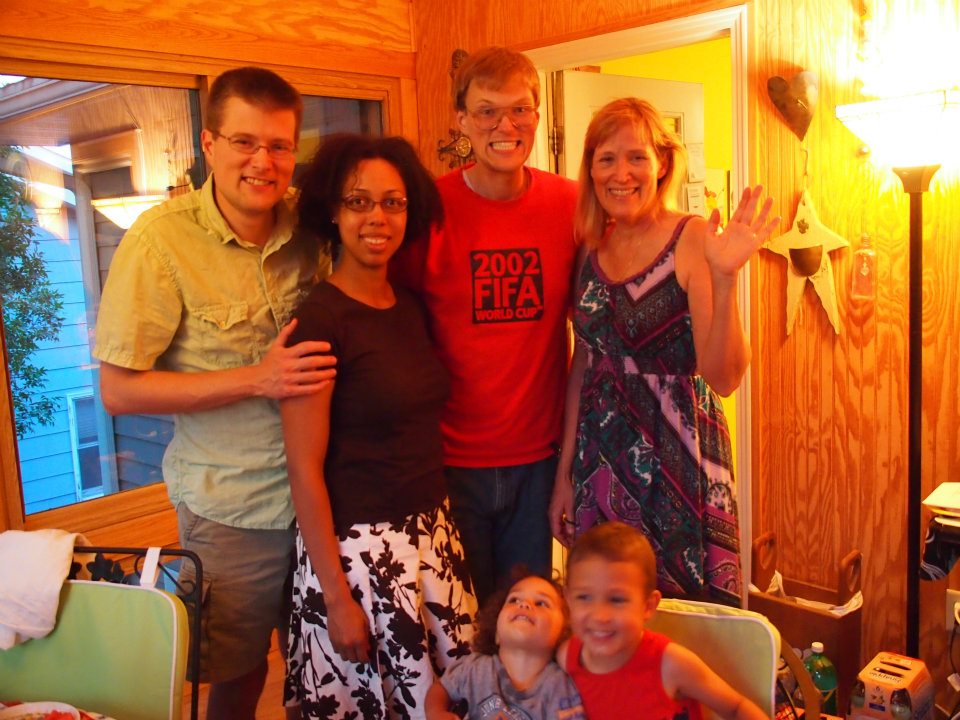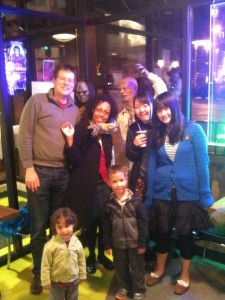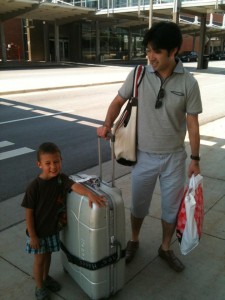Today is Labor Day. I was thinking about work, and how I work, and what I love about it, and what I might be able to offer as lessons to others from what I’ve learned from working online as a freelance writer for the past 4 years.
One of my friends posed an interesting question in response to my blog post about the “New American Dream.” He asked, “What kinds of skills do people need to learn to do the type of self-employment/freelancing/online work that you do? And how can we teach these skills in schools?”
This is a really good question that I’ve been thinking about a lot. On the one hand, much of what I do as a freelance writer is based on some fundamental academic skills – reading, writing, critical thinking. But the way I work as an online freelance writer – collaborating with multiple people on multiple continents, learning new technology, integrating different ideas – requires a certain kind of agility and curiosity that can’t necessarily be “taught” in a traditional academic environment. I sometimes think that the most important skills I’ve learned in my life have come from just doing the work.
But with that said, here are a few ideas for what kinds of “transferable skills” and personal characteristics I would recommend that people pursue – starting at a young age – if they want to be able to make a living working online as a freelancer – or at any traditional “job” that requires digital age skills:
Project Management
Project management, broadly defined, is “the art and science of getting things done.” This is one of the most important skills that is relevant to almost any good job today – you need to be able to organize a group of people, marshal your resources, analyze your budget, deadlines and constraints, and deliver a result. I manage a team of bloggers all over the U.S. Every month we have to deliver a set number of articles to our client. I’m the one who leads the team, manages the deadlines, negotiates any problems that arise along the way, and helps answer questions. I keep a detailed tracking spreadsheet that I constantly update throughout the month to make sure we’re on target to meet our goals. I love writing, but I also enjoy project management because I get to take a bigger picture view of the overall team effort. It’s like being the captain at the helm of the Starship Enterprise.
I wish more kids could get hands-on experience managing projects in school – it doesn’t have to be a “big” thing or a physical product, but learning how to meet deadlines, manage resources and guide a project to completion is one of the most important skills people can have. We’re heading toward a “project economy” where instead of traditional full-time year-round jobs, more people will work in the style of Hollywood film productions, where a team of people with specific skills will gather together for a limited time for a dedicated purpose.
Collaboration
I work “alone” most of the time, working at home from my home office or from a coffee shop on my laptop – but I never truly feel “alone” because I have clients and collaborators all over the U.S. and around the world. I love sharing ideas and pitching story ideas and exchanging feedback to make things better for whatever project we’re working on. Collaboration is more important than ever before, but it doesn’t necessarily mean you’re all going to be in the same conference room or the same city or even on the same continent. Some of my favorite people to work with during the past 4 years have been in Tokyo, Australia, Germany, London, The Netherlands, and many other places. Most of the people I’ve worked with during the past 4 years are people that I’ve never met in person. But you know what? Even though my collaborators and co-workers and clients and I are separated by thousands of miles, I often feel closer to them and more a part of their team than I did with a lot of the “in person” co-workers I used to work with at my previous jobs. Distance doesn’t matter in being a good co-worker as much as your reliability, your communication skills, and your willingness to get the job done right.
Team Building
One of the underrated skills for working online is being able to build and recruit a team for a project, and inspire that team to achieve success. How does “virtual teamwork” work, exactly? How can you build a team when you’re scattered across continents? The new style of team building does not require in-person interaction, but it does require you to set a clear vision and show each person on the team how their contribution supports the larger goals. For example, I recently built a team of blog writers from around the U.S. I reached out to friends from college, friends on Facebook, and friends of friends in specific cities where we needed writers. (The client wanted to get perspectives and insights from various geographic regions of the U.S.) As part of building my team, I wrote a lot of guidance and detailed instructions about what kind of work we’d be doing and why it was important and how they would benefit by being part of the project (in addition to the money). I had to kind of “sell” the project to the team and get them excited to be part of it by conveying the sense of fun and fulfillment that I get from working for this client. For example, most of the people I reached out to to help with this project are not full-time freelance writers, so I said to them, “How would you like to make some extra money each month with just a few hours of work?” As part of building and nurturing the team, I’ve kept up regular communication – not just via e-mail but also YouTube videos where I can give people regular updates and encouragement. I’m also available by phone whenever anyone on the team needs to talk with me or ask questions.
The new style of team building for the “project economy” and the new way of working online is not about job titles and hierarchy and following orders – it’s about flexibility, humility, generosity and a genuine spirit of helping people get better at what they do. Being a leader of a team is a great challenge and privilege, and you realize quickly that being a leader is a humbling experience – because ideally, if you’re doing it right, you should be learning much more from your team than you knew before.
Curiosity
I can find something interesting about almost anything. During the past 4 years I’ve worked with clients in all sorts of industries, including: animal pharmaceuticals, corporate law, life insurance, mobile apps, virtual events, fire extinguishers, tourism, fine wine trading, relationship coaching, life coaching, sales consulting, restaurant consulting, hospital physician recruiting, and many more. I’ve helped write screenplays (which is usually thought of as being a fun, “sexy” line of work) and I’ve also written brochures for a company that makes high-end paper shredders (which is an industry that I knew very little about), but no matter how “fun/creative” or how “dry/technical” the subject matter might be, I seem to have a knack for finding unique aspects to enjoy and find interesting. I’m often talking with my wife about something fun I learned today from my work, or some interesting facts or knowledge that I had no idea about before I started working for a particular client.
One of the most oddly fun and, well, kind of reassuring things about working online with so many clients all over the world is that the global business world is just so diverse! No matter what strange niche market or problem is out there waiting to be solved, some group of people are out there trying to solve it – trying to make a better paper shredder, or build an app, or develop some interesting solution that saves time and money. It’s not always glamorous and high-profile and sexy, but it’s what makes the world economy work.
People who want to be employable and have success in the economy of the future need to love to learn. You need to be constantly curious and willing to keep pushing the boundaries of your knowledge and get out of your comfort zone. Sometimes I take on projects even if I haven’t done something “exactly like this” before – because I have confidence that I can get up to speed on almost any learning curve, and become conversant in a variety of industries and niche topics. I don’t have to be an expert in absolutely everything – but I try to know a little about a lot.
My personal preference is that I would rather be a “generalist” than a “specialist.” My worst fear for my career is that I’ll become limited to a tiny, narrow band of expertise that makes me feel irrelevant to the larger world. However, that’s just my preference – many people work online as “specialists” in some niche field – whether that means being a freelance writer specializing in financial services, or making apps for a certain industry, or consulting for a certain size/variety of business. There’s nothing wrong with being a specialist (and finding your niche with deep expertise) or being a generalist (and serving multiple niches with a variety of skills) – the Internet makes it possible to do either one. You can either be a generalist like me, riding the wave of ever-expanding knowledge and research available online – or you can be a specialist and use online channels to connect with people who need your specific skills and expertise. But either way, you will be well-served to cultivate a strong sense of curiosity and stay eager to keep learning all the time.
Teaching
My mother teaches middle school, my father teaches college classes, and my 4 grandparents all worked as teachers/college professors at various points in their lives. Apparently I have a family gene for working in education. I worked as a teacher in my first job out of college, teaching English in Japan. They say that you never truly know anything until you teach it to someone else, and I’ve found that to be true from my work as a freelance writer.
The biggest part of my work today is content marketing – I write content for companies who want to better explain their products/services, show the value they offer, and educate their customers about why they are different from the competition. Content marketing is different from a sales letter or a brochure or a TV ad – it’s not meant to “sell” directly, it’s meant to build credibility and trust. The Internet has made it possible for people to do a lot more research than ever before when making a purchase – checking prices, comparing brands, reading customer reviews. My work as a content marketing copywriter is all about helping companies show what makes them special and explain how their products work, and exercise “thought leadership” to help guide the direction of their overall industry.
As part of this work, I need to know how to frame questions and offer thought-provoking ideas and make a “soft sell” of helping ideas to spread, but without hammering people over the head with “hard-sell” sales pitches. This is all part of being a good teacher. The best teachers don’t impose ideas upon their students, they help students discover ideas and realize the truth for themselves.
I recently was contacted by a guy who lives in the Bahamas who hired me to do some coaching via Skype to help answer some questions about how to get started working online as a marketing consultant. This was a great experience for me, because I felt like I really helped him clarify some goals and feel more confident in making a specific plan to start his own business – and I think more people will be able to make money like this in the future, just by sharing their knowledge and teaching people “how to do what I do.” The Internet has enabled more of these one-to-one connections. If you find someone’s website or follow someone on Twitter or read someone’s blog post and you feel inspired by what they do, it’s easier than ever to ask them for help. (Seriously, if you’re interested in learning more about being a freelance writer or making money online by utilizing your existing skills, please send me an e-mail: benjamin.gran@gmail.com)
Resilience
The Project Economy and working online are not for everyone, and they’re not for the faint of heart. Working online as a freelance writer or other self-employed consultant presents some unique stresses. Sometimes projects get cancelled, budgets fall through, people make promises that they cannot ultimately keep. Sometimes clients go silent. Sometimes (rarely, fortunately) people don’t pay their bills. The Project Economy and working online offer more freedom, but they also offer more uncertainty.
Perhaps the most important skill for people working online is to stay resilient. Be agile, be flexible, be able to bounce back quickly from disappointment or frustration. Keep your momentum going. Keep moving forward. Keep creating a pipeline of new business opportunities so you always have options even if a big project gets cancelled or a big client goes away.
And look, this style of work isn’t everyone’s idea of a dream job. If you want/need the predictability of a 9-5 routine, if you like the reassurance of having a physical location to report to for work each day, if you struggle to make good use of your time without a boss to guide you and help create structure for you, then maybe being a freelancer or working online isn’t the ideal fit for you. And that’s fine. But I think more people are going to seek out opportunities like these as the Project Economy expands in the years to come. More employers will realize that they can get good results without the expense and overhead of full-time employees – and more workers will realize that they can take their skills directly to the market and make more money and have more freedom than any traditional “job” could offer them.
I almost never work 8 hours a day. Sometimes I take a few days off, and then work very hard for 3 days in a row. I fit the work into my life, instead of the other way around.
I’m working today, on Labor Day, but I’m happy to do it. When you’re self-employed there are no “paid holidays,” but there are also no “Mondays,” no anxious Sunday nights dreading going back to the office the next morning. I never, ever resent a single minute I spend working, because the work is all for me and for my family, and if I do a lot more work, I make a lot more money.
I’m grateful for the experiences I’ve had and the skills I’ve developed during these past 4 years of working as a freelance writer. I hope many other people can do the same.













